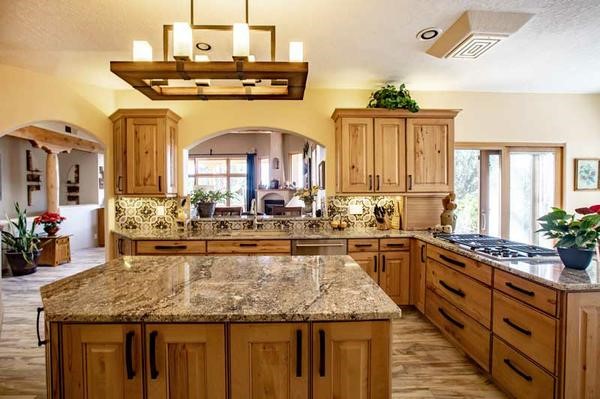Hardwood floors provide classic style, timeless beauty, and a warmth and charm that is hard to match with any other flooring option. There are many wood varieties to choose from that offer a range of grain patterns, differing levels of hardness, and a host of staining possibilities. This means that you have some choices to make when it comes to selecting and installing your hardwood floors. One of those choices is whether to go with solid or engineered hardwood. At the Poulin Design Center here in Albuquerque we want to help you make the best flooring choice for your needs. Here we have a breakdown of the positive and negative aspects of both options.
First, What’s the Difference?
After installation, solid and engineered hardwood floors are essentially indistinguishable. The difference between them lies in their construction, and is only obviously revealed if you can see beyond the top layer. Solid hardwood planks are just that – solid. They are cut from a single piece of wood. Engineered hardwood planks, on the other hand, are constructed in layers. The top layer (known as the ‘veneer’) is made from the same varieties of hardwood as the solid plank versions. Underneath the veneer, engineered hardwood incorporates plywood to form the middle and bottom layers. The two manufacturing processes create different pros and cons for each flooring type.
Solid Hardwood
Pros
Solid hardwood has been used for centuries to create beautiful floors. When properly maintained, solid hardwood flooring can last a very long time. Scratches, dings, and dents will tend to occur eventually, but solid hardwood can be sanded and refinished many times to keep it looking great. Due to its durability, refinishing potential, and general consumer appeal, solid hardwood flooring adds value to a home, and this makes it a great investment.
Cons
The major drawback of solid hardwood flooring is that it is susceptible to humidity and moisture damage. Wood is a porous material, and when too much moisture is absorbed twisting, warping, and cupping may occur. For this reason, solid hardwood flooring is not recommended for bathrooms, and is not at all suitable for installation in rooms that are below grade (such as basements). Solid hardwood flooring is also a relatively expensive flooring material, which is another downside.
Engineered Hardwood
Pros
Engineered hardwood flooring offers great durability, much like solid hardwood flooring. Less expensive options with fewer layers should last between 20 and 40 years, and higher-end varieties with more layers can last from 40 to 80 years with proper maintenance. Another major pro of engineered hardwood is that its layered construction makes it relatively resistant to moisture damage (certainly more so than solid hardwood). This makes engineered hardwood a suitable flooring material for almost any room in your home, including those that are below grade. And while it can be nailed down to a subflooring, like solid hardwood, engineered hardwood can also be installed as a “floating” floor, where the planks are glued or snapped together and not affixed to the surface below. This allows engineered hardwood to be installed atop existing flooring materials, such as linoleum, vinyl, or even tile, and also allows for installation on top of concrete. Engineered hardwood is also more environmentally friendly than solid hardwood. Due to the fact that it uses less hardwood overall in its construction, it requires fewer trees be cut down for manufacturing. Given its good durability and wide market appeal, engineered hardwood is a great investment in your home.
Cons
Although engineered hardwood can be sanded and refinished, this can only be done a handful of times at most because of the limited thickness of the hardwood veneer. So, although you can expect a long lifespan out of your engineered hardwood, it doesn’t quite have the longevity of solid planks. For this reason, major damage to part of the floor may require replacing individual planks rather than resurfacing the entire floor. This is really the only downside of engineered hardwood flooring, and it can be mitigated to a great extent with some basic care and maintenance.
Both solid and engineered hardwood flooring make excellent choices for your home, depending on the room where you would like them installed. Solid hardwood has been, and will continue to be, a staple of high-end flooring. Engineered hardwood hasn’t been around as long, but it is quickly gaining traction in the market and is becoming a favorite option amongst savvy homeowners. At the Poulin Design Center we have a huge selection of flooring for you to choose from. So, whatever you decide, we have you covered!
Photo Credit: Stock-Asso




